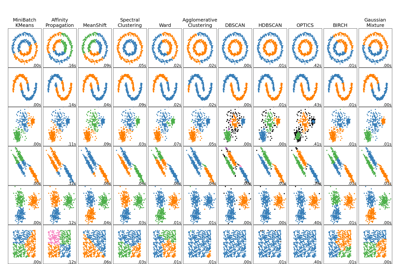W3cubDocs
/scikit-learnsklearn.cluster.SpectralClustering
-
class sklearn.cluster.SpectralClustering(n_clusters=8, eigen_solver=None, random_state=None, n_init=10, gamma=1.0, affinity='rbf', n_neighbors=10, eigen_tol=0.0, assign_labels='kmeans', degree=3, coef0=1, kernel_params=None, n_jobs=1)[source] -
Apply clustering to a projection to the normalized laplacian.
In practice Spectral Clustering is very useful when the structure of the individual clusters is highly non-convex or more generally when a measure of the center and spread of the cluster is not a suitable description of the complete cluster. For instance when clusters are nested circles on the 2D plan.
If affinity is the adjacency matrix of a graph, this method can be used to find normalized graph cuts.
When calling
fit, an affinity matrix is constructed using either kernel function such the Gaussian (aka RBF) kernel of the euclidean distancedd(X, X):np.exp(-gamma * d(X,X) ** 2)
or a k-nearest neighbors connectivity matrix.
Alternatively, using
precomputed, a user-provided affinity matrix can be used.Read more in the User Guide.
Parameters: n_clusters : integer, optional
The dimension of the projection subspace.
affinity : string, array-like or callable, default ‘rbf’
If a string, this may be one of ‘nearest_neighbors’, ‘precomputed’, ‘rbf’ or one of the kernels supported by
sklearn.metrics.pairwise_kernels.Only kernels that produce similarity scores (non-negative values that increase with similarity) should be used. This property is not checked by the clustering algorithm.
gamma : float, default=1.0
Scaling factor of RBF, polynomial, exponential chi^2 and sigmoid affinity kernel. Ignored for
affinity='nearest_neighbors'.degree : float, default=3
Degree of the polynomial kernel. Ignored by other kernels.
coef0 : float, default=1
Zero coefficient for polynomial and sigmoid kernels. Ignored by other kernels.
n_neighbors : integer
Number of neighbors to use when constructing the affinity matrix using the nearest neighbors method. Ignored for
affinity='rbf'.eigen_solver : {None, ‘arpack’, ‘lobpcg’, or ‘amg’}
The eigenvalue decomposition strategy to use. AMG requires pyamg to be installed. It can be faster on very large, sparse problems, but may also lead to instabilities
random_state : int seed, RandomState instance, or None (default)
A pseudo random number generator used for the initialization of the lobpcg eigen vectors decomposition when eigen_solver == ‘amg’ and by the K-Means initialization.
n_init : int, optional, default: 10
Number of time the k-means algorithm will be run with different centroid seeds. The final results will be the best output of n_init consecutive runs in terms of inertia.
eigen_tol : float, optional, default: 0.0
Stopping criterion for eigendecomposition of the Laplacian matrix when using arpack eigen_solver.
assign_labels : {‘kmeans’, ‘discretize’}, default: ‘kmeans’
The strategy to use to assign labels in the embedding space. There are two ways to assign labels after the laplacian embedding. k-means can be applied and is a popular choice. But it can also be sensitive to initialization. Discretization is another approach which is less sensitive to random initialization.
kernel_params : dictionary of string to any, optional
Parameters (keyword arguments) and values for kernel passed as callable object. Ignored by other kernels.
n_jobs : int, optional (default = 1)
The number of parallel jobs to run. If
-1, then the number of jobs is set to the number of CPU cores.Attributes: affinity_matrix_ : array-like, shape (n_samples, n_samples)
Affinity matrix used for clustering. Available only if after calling
fit.labels_ : :
Labels of each point
Notes
If you have an affinity matrix, such as a distance matrix, for which 0 means identical elements, and high values means very dissimilar elements, it can be transformed in a similarity matrix that is well suited for the algorithm by applying the Gaussian (RBF, heat) kernel:
np.exp(- dist_matrix ** 2 / (2. * delta ** 2))
Where
deltais a free parameter representing the width of the Gaussian kernel.Another alternative is to take a symmetric version of the k nearest neighbors connectivity matrix of the points.
If the pyamg package is installed, it is used: this greatly speeds up computation.
References
- Normalized cuts and image segmentation, 2000 Jianbo Shi, Jitendra Malik http://citeseer.ist.psu.edu/viewdoc/summary?doi=10.1.1.160.2324
- A Tutorial on Spectral Clustering, 2007 Ulrike von Luxburg http://citeseerx.ist.psu.edu/viewdoc/summary?doi=10.1.1.165.9323
- Multiclass spectral clustering, 2003 Stella X. Yu, Jianbo Shi http://www1.icsi.berkeley.edu/~stellayu/publication/doc/2003kwayICCV.pdf
Methods
fit(X[, y])Creates an affinity matrix for X using the selected affinity, then applies spectral clustering to this affinity matrix. fit_predict(X[, y])Performs clustering on X and returns cluster labels. get_params([deep])Get parameters for this estimator. set_params(**params)Set the parameters of this estimator. -
__init__(n_clusters=8, eigen_solver=None, random_state=None, n_init=10, gamma=1.0, affinity='rbf', n_neighbors=10, eigen_tol=0.0, assign_labels='kmeans', degree=3, coef0=1, kernel_params=None, n_jobs=1)[source]
-
fit(X, y=None)[source] -
Creates an affinity matrix for X using the selected affinity, then applies spectral clustering to this affinity matrix.
Parameters: X : array-like or sparse matrix, shape (n_samples, n_features)
OR, if affinity==`precomputed`, a precomputed affinity matrix of shape (n_samples, n_samples)
-
fit_predict(X, y=None)[source] -
Performs clustering on X and returns cluster labels.
Parameters: X : ndarray, shape (n_samples, n_features)
Input data.
Returns: y : ndarray, shape (n_samples,)
cluster labels
-
get_params(deep=True)[source] -
Get parameters for this estimator.
Parameters: deep: boolean, optional :
If True, will return the parameters for this estimator and contained subobjects that are estimators.
Returns: params : mapping of string to any
Parameter names mapped to their values.
-
set_params(**params)[source] -
Set the parameters of this estimator.
The method works on simple estimators as well as on nested objects (such as pipelines). The latter have parameters of the form
<component>__<parameter>so that it’s possible to update each component of a nested object.Returns: self :
Examples using sklearn.cluster.SpectralClustering
© 2007–2016 The scikit-learn developers
Licensed under the 3-clause BSD License.
http://scikit-learn.org/stable/modules/generated/sklearn.cluster.SpectralClustering.html
